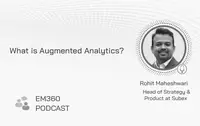
What is Augmented Analytics?
With new analytic trends emerging as we delve deeper into this decade, organisations are starting to pay attention to solutions and tools that offer them greater insights into their data. A study from Forrester Research revealed that less than 0.5% of all data is ever analysed and used, while only 12% of enterprise data is used to make decisions. As it currently stands, much of our data is confined to silos, meaning that it is too segmented to be analysed, while many organisations still have not received enough training to empower their data scientists and fix the data gap. The quickest solution would be to invest in a technology that performs much of the analysis for you automatically, i.e. augmented analytics.
What is Augmented Analytics?
Augmented analytics is one of the latest data trends and for good reason; it implements machine learning and natural language processing to automate analysis processes that would usually be conducted by an expert in that field. Essentially, data is processed faster than it would be by a human, which also makes it cost effective. Despite this, some organisations remain concerned about the implementation process, the perceived risks and the costs.
Joining us in this EM360 podcast is Rohit Maheshwari, Head of Strategy and Product at Subex. In this episode, we talk to him in depth about the benefits of augmented analytics, how it can bring value to your business and the restrictions of legacy software.
'What is Augmented Analytics?' can also be found on Spotify and Apple Podcasts.







